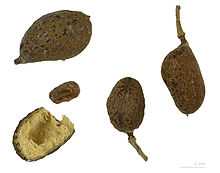Hymenaea
| Hymenaea | |
|---|---|
 | |
| Hymenaea stigonocarpa | |
| Scientific classification | |
| Kingdom: | Plantae |
| Clade: | Angiosperms |
| Clade: | Eudicots |
| Clade: | Rosids |
| Order: | Fabales |
| Family: | Fabaceae |
| Tribe: | Detarieae |
| Genus: | Hymenaea L. |
| Type species | |
| Hymenaea courbaril L. | |
| Species | |
|
see text | |


Hymenaea L. is a genus in the flowering plant family Fabaceae (legume family). Of fourteen living species in the genus, all but one are native to the tropics of the Americas, with one additional species (Hymenaea verrucosa) on the east coast of Africa. Some authors place the African species in a separate monotypic genus, Trachylobium.[1] In the neotropics, Hymenaea is distributed through the Caribbean islands, and from southern Mexico to Brazil. Linnaeus named the genus in 1753 in Species Plantarum for Hymenaios, the Greek god of marriage ceremonies. The name is a reference to the paired leaflets.
In Colombia the trees are called algarrobo, and in Peru azúcar huayo. The Brazilian name is jatobá.
Most species of Hymenaea are large trees and they are primarily evergreen. They may grow to a height of 25 m (82 ft) and emerge above the forest canopy. Some species will grow both as tall forest trees and as smaller shrubby trees depending on their surrounding habitat. The leaves are pinnately bifoliolate, meaning that they have two leaflets attached to the sides of the petiole. The flowers grow in a panicle or corymb type of inflorescence.
Uses and properties
The pulpy center of the fruits are edible and contain starch. The fruit is sold in local markets in the Americas. The leaves may be used to make a tea. The trees produce a dense wood used for timber in making ships and furniture. The thick bark of some species is used by indigenous peoples of the Amazon to make canoes. Seeds contain large amounts (40% of dry weight) of a highly viscous polysaccharide (xyloglucan) which can be used in several industrial sectors such as food, paper, cosmetic and pharmaceutical.
The trees also make hard resins that are used to manufacture varnish, especially the resin from Hymenaea courbaril (jatobá) in Brazil. The resin that is produced in Brazil is known as South American copal, and Hymenaea verrucosa is the source of the valuable Zanzibar copal. Resin may be collected from living trees, or from the soil near the place where a tree once stood. Throughout its American range, indigenous peoples use the resin for incense and as a cement. Resin from the extinct species Hymenaea protera is the source of Dominican amber, while the extinct Hymenaea mexicana produced the resin which is the source of Mexican amber.[2]
Hymenaea courbaril has been used as a model organism to study the effect of increased CO2 concentration on the rate of photosynthesis in neotropical regions.[3] When the concentration of CO2 was increased from an ambient reference level of 360ppm to 720ppm, the photosynthetic CO2 assimilation in the seedlings doubled.[3] This suggests the species could play an important role in greenhouse gas sequestration, as atmospheric CO2 is expected to reach ca. 700 ppm by the year 2075 if current levels of fossil fuel consumption are maintained.[4]
Seedling establishment is promoted by xyloglucan mobilization during development in Hymenaea courbaril. Seeds germinate after about 18 days and start xyloglucan mobilization after 45 days. This takes place for about 20 days, when photosynthesis is established and the seedling becomes independent.
One of the signs that storage mobilization is occurring is that young leaves become red due to the presence of anthocyanins.
Seedlings from the rain forest invest 70% of their carbon in the aerial parts whereas the one from savannah invests around 70% of absorbed carbon on root development.
Hymenaea is a very important species in programmes of recuperation of degraded rain forests in the Neotropics.[citation needed] Regarding ecological succession, Hymenaea courbaril appears late in the process being classified as a 'late successional' or climax species.
Species
- †Hymenaea allendis
- Hymenaea aurea
- Hymenaea courbaril
- Hymenaea eriogyne
- Hymenaea intermedia
- Hymenaea maranhensis
- Hymenaea martiana
- †Hymenaea mexicana
- Hymenaea oblongifolia
- Hymenaea parvifolia
- †Hymenaea protera
- Hymenaea reticulata
- Hymenaea rubriflora
- Hymenaea stigonocarpa
- Hymenaea torrei
- Hymenaea velutina
- Hymenaea verrucosa
See also
- Animé, an oleo-resin from Hymenaea species.
References
- ↑ Gwilym Lewis, Brian Schrire, Barbara MacKinder, and Mike Lock. 2005. Legumes of the World. Royal Botanic Gardens, Kew: Richmond, England.
- ↑ Poinar, G.; Brown, A. (2002). "Hymenaea mexicana sp. nov. (Leguminosae: Caesalpinioideae) from Mexican amber indicates Old World connections". Botanical Journal of the Linnean Society 139 (2): 125–132. doi:10.1046/j.1095-8339.2002.00053.x.
- ↑ 3.0 3.1 Aidar et al., M.P.M. (2002). "Effect of atmospheric CO2 enrichment on the establishment of seedlings of jatobá, Hymenaea Courbaril L.". Biota Neotropica 2 (1): 10.
- ↑ Houghton et al. (Eds), J.T (1996). Climate Change 1995: The Science of Climate Change. Cambridge, UK: Cambridge University Press.
- Aidar M.P.M., Martinez C. A., Costa A. C., Costa P. M. F., Dietrich S. M. C., Buckeridge M. S. (2002) Effect of atmospheric CO2 enrichment on the establishment of seedlings of jatobá, Hymenaea courbaril L. (Leguminosae, Caesalpinioideae) Biota Neotropica. 2(1):(http://www.biotaneotropica.org.br/v2n1/en/abstract?article+BN01602012002).
- Buckeridge, M.S. & Aidar, M.P.M. (2002) Carbon sequestration in the rain forest: alternatives using environmentally friendly biotechnology. Biota Neotropica 2(1): (http://www.biotaneotropica.org.br/v2n1/en/item?point-of-view).
- Gentry, Alwyn H. (1996). A Field Guide to the Families and Genera of Woody Plants of Northwest South America (Colombia, Ecuador, Peru). Chicago: University of Chicago Press. ISBN 0-226-28944-3.
- Lima, D.U., Chaves, R.O. & Buckeridge, M.S. (2003) Seed storage hemicelluloses as wet-end additives in papermaking. Carbohydrate polymers 52:367-373.
- Lee, Yin-Tse & Langenheim, Jean H. (1975). Sytematics of the genus Hymenaea L. (Leguminosae, Caesalpinioideae, Detarieae). University of California Publications in Botany 69.
- Mabberley, D. J. (1987). The Plant Book: A Portable Dictionary of the Higher Plants. Cambridge: Cambridge University Press. ISBN 0-521-34060-8.
- Poinar, George Jr. & Brown, Alex E. (2002). Hymenaea mexicana sp. nov. (Leguminosae: Caesalpinioideae) from Mexican amber indicates Old World connections. Botanical J. of the Linnaean Soc. 139(2): 125.
- Santos, H.P., Purgato, E., Mercier, H. & Buckeridge, M.S. (2004) The control of storage xyloglucan mobilization in cotyledons of Hymenaea courbaril L. Plant Physiology 135:287-299.http://www.plantphysiol.org/cgi/content/abstract/135/1/287
- Santos, H.P. & Buckeridge, M.S. (2004) The role of the storage carbon of cotyledons in the establishment of seedlings of Hymenaea courbaril under different light conditions. Annals of Botany. 94(6) 819-830.http://aob.oxfordjournals.org/cgi/content/full/94/6/819